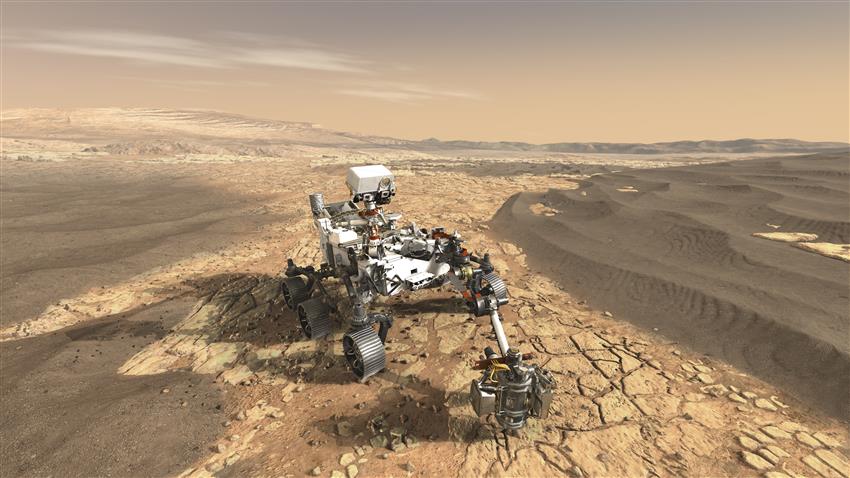Mars : Searching for signs of past life on the red planet
- Launch:
- Arrival:
- Mission status: Active
Rovers sent to Mars – like Spirit, Opportunity, and Curiosity – are designed to be the eyes and hands of scientists. Using their miniaturized tools and instruments, they analyze hundreds of rock and soil samples right on the spot and send data back to Earth.
NASA's Mars rover, Perseverance, will use a drill to collect samples in precise locations selected by terrestrial experts. For the first time on the red planet, these small quantities of rock will be sealed and stored for possible return to Earth.
Perseverance is operating in Jezero Crater, a location just north of Mars's equator, which is home to several different types of rock that will help scientists meet their mission objectives. As part of future missions, the samples collected by Perseverance could later be retrieved and brought to Earth for analysis with the full range of instruments available to scientists. The Mars mission will address fundamental questions about the potential for life on Mars.
According to current plans, the Mars Sample Return campaign would involve several steps:
- Selection and collection: The Perseverance rover team selects the samples, and the rover collects them. The samples are either left at a specific location or carried onboard.
- Transfer and retrieval: Perseverance is the primary means of transporting samples to the Sample Retrieval Lander (SRL). The SRL also includes two sample recovery helicopters, which may retrieve additional samples collected by Perseverance.
- Ascent: The SRL includes the Mars Ascent Vehicle and the Sample Transfer Arm to take the sealed tubes containing samples of Martian rocks and soils into Mars orbit.
- Rendezvous in Martian orbit: The Earth Return Orbiter waits in orbit around Mars to meet with the Mars Ascent Vehicle to capture the sample container using the Capture, Containment and Return System to prepare for return to Earth.
- Sample return: The pristine samples could arrive on Earth as early as .
Objectives
The objectives of the Mars mission are to:
- Determine whether habitable conditions ever existed on Mars
- Look for signs of past microbial life
- Learn more about Mars's geology and current climate
- Prepare for human exploration
Scientists also learn about Mars through Martian meteorites, pieces of the red planet that have travelled here after being knocked off in cosmic collisions.
But surviving the journey through Earth's atmosphere means that these fragments are made of strong material which does not fully represent all types of rock on Mars. In fact, scientists believe evidence of past life could be locked inside rocks on Mars that are different in makeup from the meteorites that have landed here on Earth.
By using the Mars rover to analyze the rocks, scientists are paving the way for a new understanding of our planetary neighbour.

In this view taken by its Mastcam-Z instrument, the Perseverance rover can see a remnant of a fan-shaped deposit of sediments known as a delta. Scientists believe this delta – the raised area of dark brown rock – is what remains of the confluence between an ancient river and a lake at Mars's Jezero Crater. (Credit: NASA/JPL-Caltech/ASU/MSSS)
Canada's role in the mission

Dr. Chris Herd, professor of Earth and atmospheric sciences at the University of Alberta. (Credit: Faculty of Science, University of Alberta)

Dr. Mariek Schmidt, associate professor of Earth sciences at Brock University. (Credit: Brian Scott)

Dr. Richard Léveillé, adjunct professor, Department of Earth and Planetary Sciences at McGill University. (Credit: R. Léveillé)

Dr. Ed Cloutis, professor of geography and Director of the Centre for Terrestrial and Planetary Exploration at the University of Winnipeg. (Credit: University of Winnipeg)

Dr. Kim Tait, Teck Endowed Chair of Mineralogy at the Royal Ontario Museum and Professor at the University of Toronto. (Credit: Saty + Pratha)
The Canadian Space Agency is funding Canadian institutions to support five scientists' participation in the Mars mission:
- Dr. Chris Herd, professor of Earth and atmospheric sciences at the University of Alberta, is working as a Participating Sample Scientist. Dr. Herd was selected by NASA as one of 10 experts designated to enhance the scientific value of the samples to be collected by the mission. He was also chosen to serve as one of two Returned Sample Scientist representatives on the mission's Project Science Group. In this role, he is part of the team responsible for making critical operational and scientific decisions for the mission. Dr. Herd is contributing his expertise in the analysis of igneous rocks and Martian meteorites to select samples that are most likely to provide key information about Mars's geological history.
- Dr. Mariek Schmidt, associate professor of Earth sciences at Brock University, is taking part in the mission as a Participating Scientist. Dr. Schmidt will use data collected by the rover's PIXL instrument, which is designed to measure, at a very tiny scale, the elemental makeup of Martian rocks and soil. Her work focuses on the dust on the surface of rocks, and how the presence of dust influences the chemical measurements taken by PIXL and similar instruments. Dr. Schmidt will also use PIXL data to interpret the geological history of rocks encountered by the Perseverance rover.
- Dr. Richard Léveillé, adjunct professor, Department of Earth and Planetary Sciences at McGill University, is a Co-Investigator on the SuperCam instrument, an imager located on the "head" of the rover's mast. The instrument examines rocks and soils for minerals and organic material, performing analyses on tiny samples from up to seven metres away. Dr. Léveillé will use data gathered by SuperCam to map levels of nitrogen trapped in Martian rock – a key clue for past habitability of Mars.
- Dr. Ed Cloutis, professor of geography and Director of the Centre for Terrestrial and Planetary Exploration at the University of Winnipeg, is a Co-Investigator on the Mastcam-Z instrument, a camera system that acts like the "
eyes
" of the Perseverance rover. Thanks to its powerful zoom and 360-degree, three-dimensional vision, the instrument offers detailed views of the red planet's surface. Dr. Cloutis and his team will use images gathered by Mastcam-Z to support analysis of data gathered by the rover. - Dr. Kim Tait, Teck Endowed Chair of Mineralogy at the Royal Ontario Museum and Professor at the University of Toronto, was selected by NASA to work on the Mars Sample Return Campaign Science Group. As an expert in geological and meteoritic research, she will be among 16 distinguished, field-leading scientists who will make strategic decisions in planning and executing a complete Mars Sample Return campaign, a multi-mission initiative to send Perseverance's collected and cached samples to Earth for in-depth analysis.
Igneous rocks are one of three main types of rocks (along with sedimentary and metamorphic). They form when magma (molten rock) cools and crystallizes. They can have many different compositions, depending on what kind of magma they come from, and can vary in appearance based on their cooling conditions.
Explore further
- The InSight mission: Beneath the surface of Mars
- Curiosity and the Mars Science Laboratory Mission
- Planet Mars in numbers - Infographic
- Date modified:

